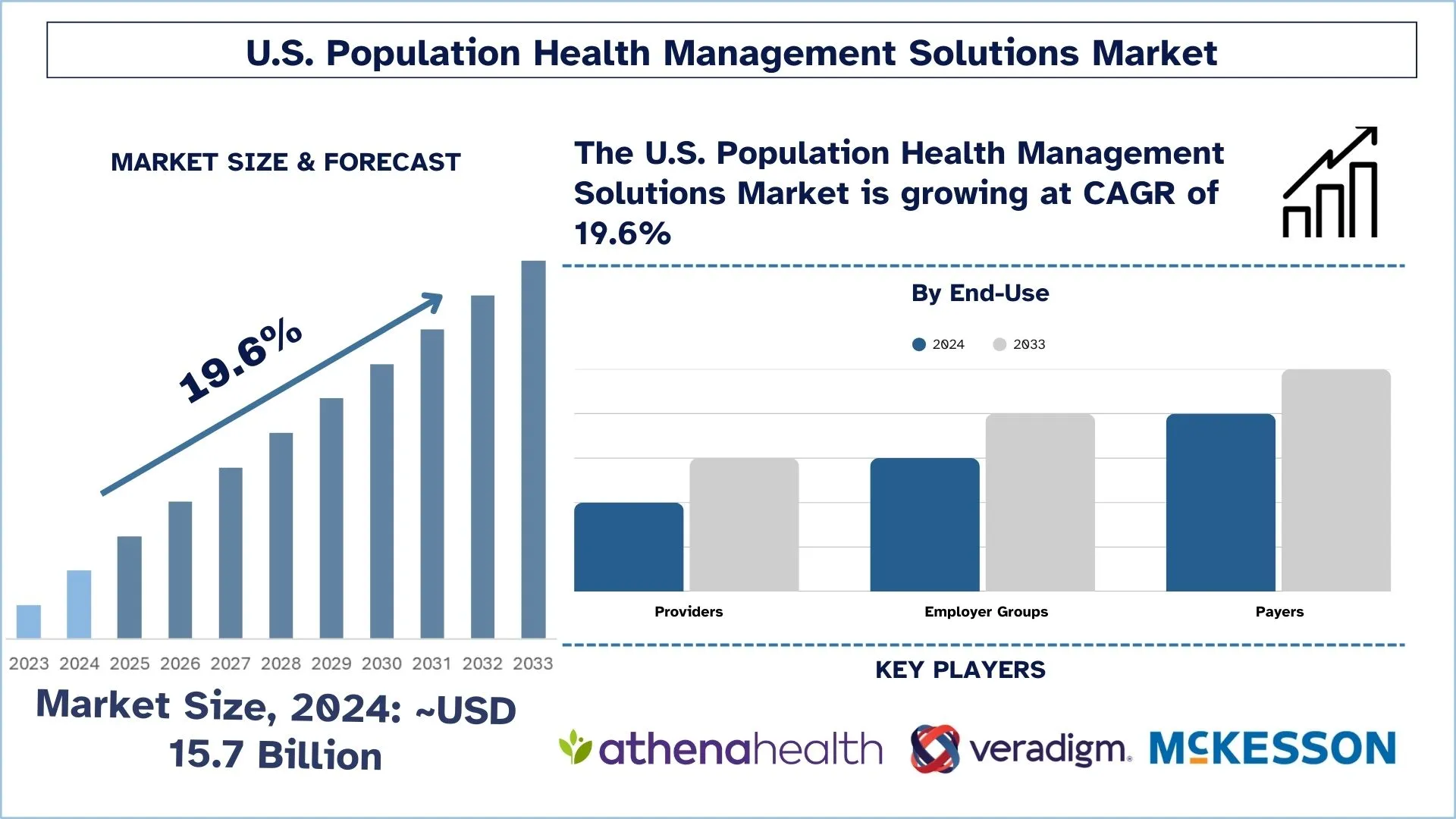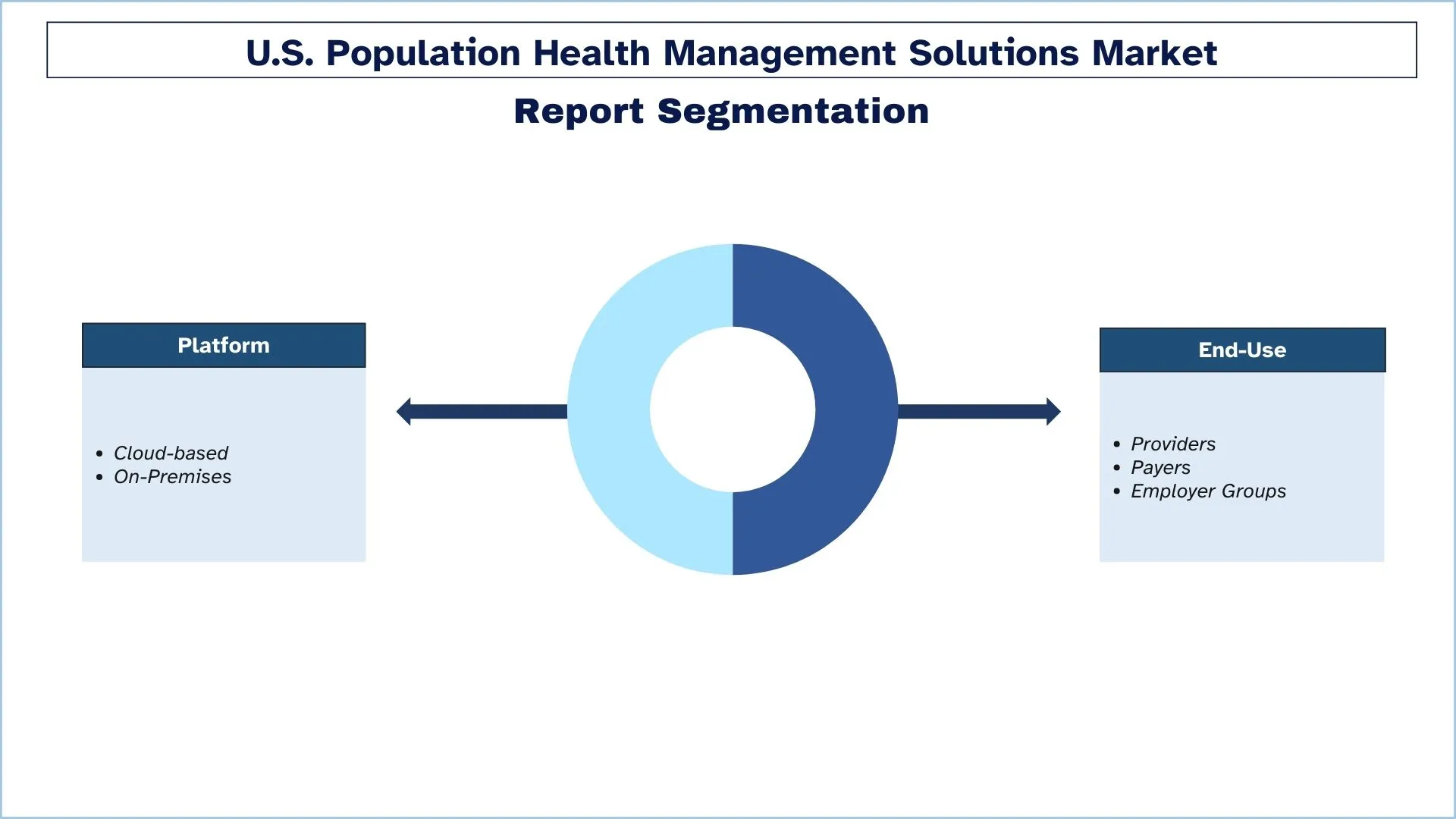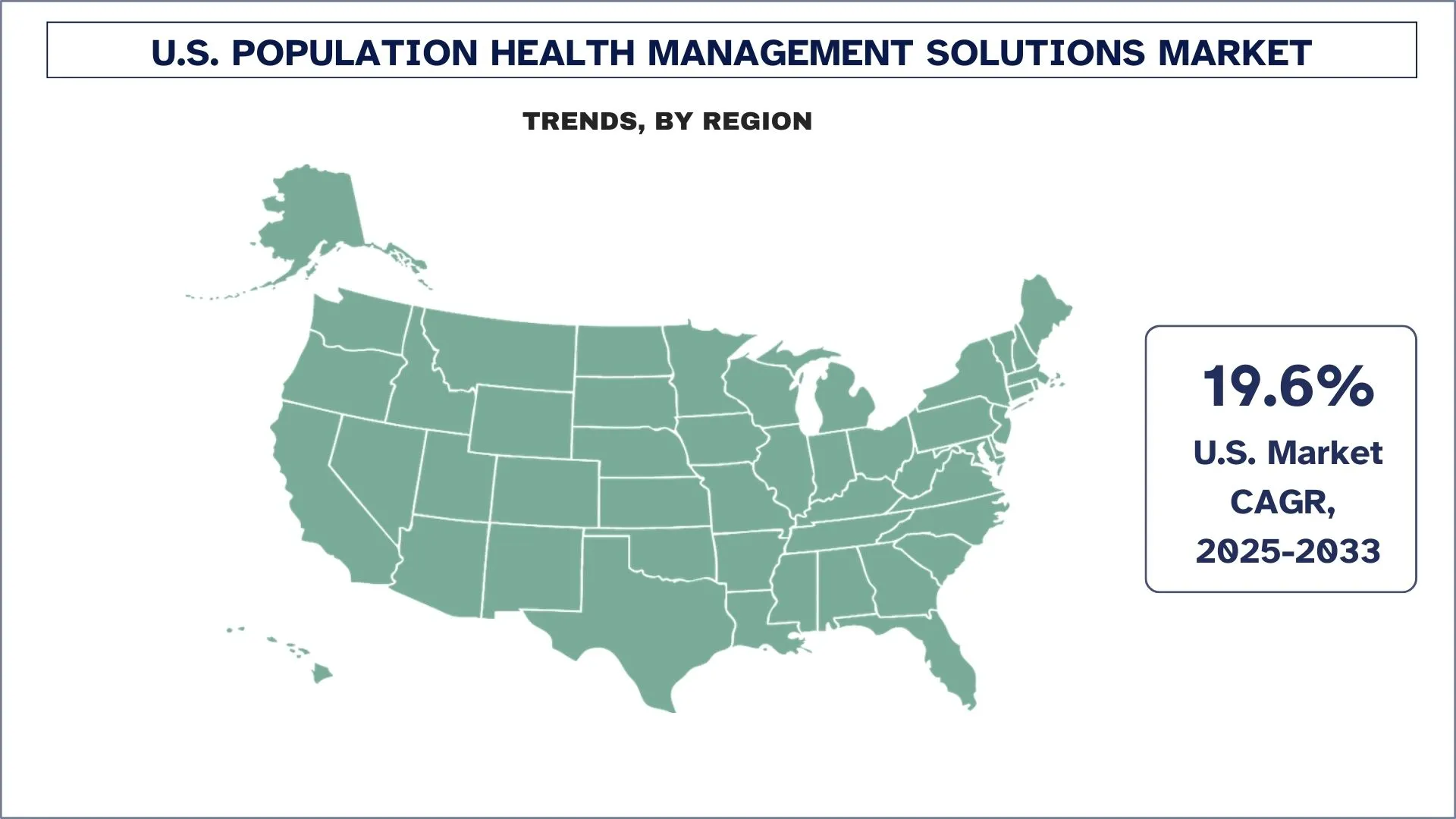Рынок решений для управления здоровьем населения в США: текущий анализ и прогноз (2025-2033 гг.)
Акцент на платформе (облачная и локальная); конечном использовании (провайдеры, плательщики, группы работодателей); и штатах

Размер и прогноз рынка решений для управления здоровьем населения США
Объем рынка решений для управления здоровьем населения США оценивался примерно в 15,7 млрд долларов США в 2024 году и, как ожидается, будет расти со значительным среднегодовым темпом роста около 19,6% в течение прогнозируемого периода (2025-2033 гг.) из-за растущего бремени хронических заболеваний и старения населения.
Анализ рынка решений для управления здоровьем населения США
Рынок решений для управления здоровьем населения в США - это быстрорастущая отрасль, которая сосредоточена на улучшении здоровья и благополучия групп пациентов с помощью технологий и анализа данных. Решения для управления здоровьем населения предназначены для того, чтобы помочь поставщикам медицинских услуг управлять группами пациентов, выявлять пациентов с высоким риском и оказывать надлежащую помощь для улучшения результатов лечения пациентов. Рынок решений для управления здоровьем населения в США обусловлен несколькими факторами, в том числе растущей распространенностью хронических заболеваний, необходимостью управления расходами на здравоохранение и растущим спросом на удаленный мониторинг пациентов и услуги телемедицины. Решения для управления здоровьем населения могут помочь поставщикам медицинских услуг управлять группами пациентов, выявлять пациентов с высоким риском и оказывать надлежащую помощь для улучшения результатов лечения пациентов.
Тенденции рынка решений для управления здоровьем населения США
В этом разделе рассматриваются основные рыночные тенденции, влияющие на различные сегменты рынка решений для управления здоровьем населения США, выявленные нашими экспертами-исследователями.
Переход к моделям оказания медицинской помощи, ориентированным на ценность
Рынок решений для управления здоровьем населения в США претерпевает радикальную трансформацию, поскольку организации здравоохранения переходят к моделям оказания медицинской помощи, ориентированным на ценность, вместо традиционных моделей, основанных на объеме. Поставщики медицинских услуг и плательщики проявляют повышенный интерес к платформам PHM, потому что эта тенденция фокусируется на предоставлении профилактической помощи и лучших результатов лечения пациентов, а также на повышении экономической эффективности. Решения помогают выполнять анализ в режиме реального времени и разделять пациентов на группы, а также управлять скоординированным лечением, соответствуя требованиям возмещения, основанного на ценности. В настоящее время организации сосредотачивают свои инвестиции на инструментах популяционного уровня в сочетании с системами управления рисками и решениями для персонализированного ухода, чтобы удовлетворить растущие потребности в системах здравоохранения, ориентированных на ценность.
Сегментация индустрии решений для управления здоровьем населения США
В этом разделе представлен анализ основных тенденций в каждом сегменте отчета о рынке решений для управления здоровьем населения США, а также прогнозы на региональном уровне на 2025-2033 годы.
Облачный сегмент занимает наибольшую долю рынка решений для управления здоровьем населения США.
На основе платформы рынок разделен на облачный и локальный. Среди них ожидается, что облачный сегмент будет занимать основную долю рынка решений для управления здоровьем населения в США в течение прогнозируемого периода. Облачные решения предлагают ряд преимуществ по сравнению с локальными решениями, включая более низкие первоначальные затраты, масштабируемость и более простое обслуживание. Облачные решения можно легко масштабировать вверх или вниз в зависимости от потребностей пользователя, и поставщик несет ответственность за обслуживание инфраструктуры, что может сэкономить время и ресурсы поставщиков медицинских услуг. Облачные решения обеспечивают большую гибкость и доступность, поскольку к ним можно получить доступ из любого места, где есть подключение к Интернету. Это может быть особенно важно для сельских и отдаленных районов, где доступ к поставщикам медицинских услуг может быть ограничен.
Ожидается, что сегмент плательщиков продемонстрирует более высокий среднегодовой темп роста, чем рынок решений для управления здоровьем населения США.
На основе конечного использования рынок сегментирован на поставщиков, плательщиков и группы работодателей. Среди них ожидается, что плательщики будут занимать основную долю рынка решений для управления здоровьем населения в США в течение прогнозируемого периода. Сегмент плательщиков будет занимать основную долю рынка в течение прогнозируемого периода. Плательщики, такие как компании медицинского страхования и государственные учреждения, играют важную роль в управлении здоровьем населения, поскольку они несут ответственность за финансирование медицинских услуг. Плательщики заинтересованы в решениях для управления здоровьем населения, которые могут помочь снизить расходы на здравоохранение, улучшить результаты лечения пациентов и расширить доступ к медицинской помощи.

Калифорния занимает значительную долю рынка в 2024 году.
Рынок решений для управления здоровьем населения (PHM) в Калифорнии претерпевает значительные изменения из-за усилий на уровне штата по улучшению медицинских услуг и результатов лечения пациентов. Департамент медицинских услуг (DHCS) инициировал Программу управления здоровьем населения в рамках своей инициативы CalAIM. Программа управления здоровьем населения для членов Medi-Cal обеспечивает комплексный персонализированный подход к здоровью, который направлен на улучшение результатов и равные возможности лечения для всех групп населения, включая детей и беременных, а также пожилых людей и инвалидов. Эта инициатива демонстрирует стремление Калифорнии объединить системы управления медицинской помощью с инструментами вовлечения пациентов и электронными медицинскими картами для создания единой структуры здравоохранения. Акцент на профилактической медицине, а также на решениях по устранению неравенства, позволит Калифорнии стать примером в управлении здоровьем населения для создания эффективной и справедливой системы здравоохранения.
Конкурентная среда индустрии решений для управления здоровьем населения США
Рынок решений для управления здоровьем населения США является конкурентным, с участием нескольких глобальных и международных игроков. Ключевые игроки применяют различные стратегии роста для расширения своего присутствия на рынке, такие как партнерства, соглашения, сотрудничество, запуск новых продуктов, географическое расширение, а также слияния и поглощения.

Ведущие компании, предлагающие решения для управления здоровьем населения в США
Некоторые из основных игроков, работающих на рынке: Veradigm Inc.; Cerner Corp. (Oracle); Conifer Health Solutions, LLC (Tenet Healthcare); EClinicalWorks; Enli Health Intelligence (Cedar Gate); McKesson Corp.; Medecision (Health Care Service Corporation (HCSC)); Optum, Inc. (UnitedHealth Group); Koninklijke Philips N.V.; athenahealth, Inc. (Bain Capital and Hellman & Friedman)
Последние события на рынке решений для управления здоровьем населения в США
В апреле 2022 г. Medecision, ведущая компания в области цифрового управления медицинской помощью, объявила о начале стратегического партнерства с Clearstep Health для разработки улучшенного взаимодействия с пациентами для существующих, а также новых планов и систем здравоохранения.
Обзор отчета о рынке решений для управления здоровьем населения в США
Атрибут отчета | Подробности |
Базовый год | 2024 |
Прогнозный период | 2025-2033 |
Импульс роста | Ускорение при среднегодовом темпе роста 19,6% |
Размер рынка в 2024 году | 15,7 млрд долларов США |
Основной вклад вносит регион | Ожидается, что Калифорния будет расти самыми высокими темпами среднегодового роста в течение прогнозируемого периода. |
Основные охваченные регионы | Калифорния, Нью-Йорк, Флорида, Вашингтон, Техас, остальная часть США. |
Профилированные компании | Veradigm Inc.; Cerner Corp. (Oracle); Conifer Health Solutions, LLC (Tenet Healthcare); EClinicalWorks; Enli Health Intelligence (Cedar Gate); McKesson Corp.; Medecision (Health Care Service Corporation (HCSC)); Optum, Inc. (UnitedHealth Group); Koninklijke Philips N.V.; athenahealth, Inc. (Bain Capital and Hellman & Friedman) |
Область применения отчета | Тенденции рынка, движущие силы и ограничения; Оценка доходов и прогноз; Анализ сегментации; Анализ спроса и предложения; Конкурентная среда; Профилирование компаний |
Охваченные сегменты | По платформе, по конечному использованию, по региону/стране |
Причины купить отчет о рынке решений для управления здоровьем населения в США:
Исследование включает в себя анализ размера рынка и прогнозирования, подтвержденный проверенными ключевыми экспертами отрасли.
Отчет представляет собой краткий обзор общей эффективности отрасли с первого взгляда.
Отчет охватывает углубленный анализ известных участников отрасли с основным акцентом на ключевые финансовые показатели бизнеса, портфели продуктов, стратегии расширения и последние разработки.
Подробное изучение движущих сил, ограничений, ключевых тенденций и возможностей, преобладающих в отрасли.
Исследование всесторонне охватывает рынок по различным сегментам.
Углубленный анализ отрасли на региональном уровне.
Варианты настройки:
Рынок решений для управления здоровьем населения США можно дополнительно настроить в соответствии с требованиями или любым другим сегментом рынка. Кроме того, UnivDatos понимает, что у вас могут быть свои собственные бизнес-потребности; поэтому не стесняйтесь обращаться к нам, чтобы получить отчет, который полностью соответствует вашим требованиям.
Содержание
Методология исследования для анализа рынка решений по управлению здоровьем населения США (2023-2033 гг.)
Мы проанализировали исторический рынок, оценили текущий рынок и спрогнозировали будущий рынок решений по управлению здоровьем населения США, чтобы оценить его применение в основных регионах мира. Мы провели исчерпывающее вторичное исследование для сбора исторических данных о рынке и оценки текущего размера рынка. Чтобы подтвердить эти данные, мы внимательно изучили многочисленные результаты и предположения. Кроме того, мы провели углубленные первичные интервью с отраслевыми экспертами по всей цепочке создания стоимости решений по управлению здоровьем населения США. После проверки рыночных показателей посредством этих интервью мы использовали подходы «сверху вниз» и «снизу вверх» для прогнозирования общего размера рынка. Затем мы использовали методы декомпозиции рынка и триангуляции данных для оценки и анализа размера рынка отраслевых сегментов и подсегментов.
Разработка рынка
Мы использовали методы триангуляции данных для завершения общей оценки рынка и получения точных статистических данных для каждого сегмента и подсегмента рынка решений по управлению здоровьем населения США. Мы разделили данные на несколько сегментов и подсегментов, проанализировав различные параметры и тенденции, включая платформу, конечное использование и регионы на рынке решений по управлению здоровьем населения США.
Основная цель исследования рынка решений по управлению здоровьем населения США заключается в следующем:
В исследовании определяются текущие и будущие тенденции на рынке решений по управлению здоровьем населения США, предоставляя стратегические идеи для инвесторов. В нем освещается привлекательность регионального рынка, что позволяет участникам отрасли осваивать неиспользованные рынки и получать преимущество первопроходца. Другие количественные цели исследований включают:
Анализ размера рынка: Оценка текущего и прогнозируемого размера рынка решений по управлению здоровьем населения США и его сегментов в стоимостном выражении (доллары США).
Сегментация рынка решений по управлению здоровьем населения США: В исследовании рынок сегментируется по платформе, конечному использованию и региону.
Нормативно-правовая база и анализ цепочки создания стоимости: Изучение нормативно-правовой базы, цепочки создания стоимости, поведения потребителей и конкурентной среды отрасли решений по управлению здоровьем населения США.
Региональный анализ: Проведение подробного регионального анализа для ключевых областей, таких как Калифорния, Нью-Йорк, Флорида, Вашингтон, Техас, остальная часть США.
Профили компаний и стратегии роста: Профили компаний на рынке решений по управлению здоровьем населения США и стратегии роста, принятые лидерами рынка для поддержания быстрорастущего рынка.
Часто задаваемые вопросы Часто задаваемые вопросы
В1: Каков текущий размер рынка решений для управления здоровьем населения в США и его потенциал роста?
По состоянию на 2024 год, объем рынка решений для управления здоровьем населения в США оценивается примерно в 15,7 миллиардов долларов США и, как ожидается, будет расти со среднегодовым темпом роста (CAGR) в 19,6% до 2033 года.
Q2: Что является движущими факторами роста рынка решений для управления здоровьем населения США?
Растущая распространенность хронических заболеваний, таких как диабет, болезни сердца, а также старение населения стимулируют спрос на решения PHM, обеспечивающие проактивный, скоординированный уход.
В3: Какой сегмент имеет наибольшую долю на рынке решений для управления здоровьем населения США по конечному использованию?
В настоящее время сегмент плательщиков занимает наибольшую долю рынка в сегменте конечного использования.
Q4: Каковы основные тенденции на рынке решений для управления здоровьем населения в США?
Поставщики медицинских услуг все чаще внедряют инструменты управления здоровьем населения для поддержки оказания медицинской помощи, ориентированной на ценность, уделяя особое внимание профилактическому уходу, вовлечению пациентов и возмещению расходов, основанному на результатах.
В5: Какой регион будет доминировать на рынке костных сонометров?
Калифорния лидирует на рынке решений для управления здоровьем населения в США.
Q6: Какие самые большие проблемы на рынке решений для управления здоровьем населения в США?
Разрозненные системы здравоохранения и отсутствие стандартизированных форматов данных затрудняют интеграцию информации о пациентах между поставщиками медицинских услуг, что ограничивает эффективность стратегий в области здоровья населения.
Q7: Кто является ведущими игроками на рынке решений для управления здоровьем населения в США?
Ведущие компании, определяющие инновации в сфере решений для управления здоровьем населения в США, включают в себя:
• Veradigm Inc.
• Cerner Corp. (Oracle)
• Conifer Health Solutions, LLC (Tenet Healthcare)
• EClinicalWorks
• Enli Health Intelligence (Cedar Gate)
• McKesson Corp.
• Medecision (Health Care Service Corporation (HCSC))
• Optum, Inc. (UnitedHealth Group)
• Koninklijke Philips N.V.
• athenahealth, Inc. (Bain Capital and Hellman & Friedman)
Q8: Какие ключевые технологические инновации формируют рынок решений для управления здоровьем населения в США?
Новые технологии, такие как аналитика на основе ИИ, облачные платформы и интеграция данных в реальном времени, коренным образом меняют решения в области PHM. Эти инновации позволяют улучшить стратификацию рисков, предиктивное моделирование и более персонализированные планы лечения, основанные на данных и соответствующие моделям здравоохранения, ориентированным на ценность.
Q9: Как инвесторы могут оценить перспективные возможности на рынке PHM-решений в США?
Инвесторам следует оценивать компании с масштабируемыми платформами, прочными партнерскими отношениями с плательщиками и поставщиками медицинских услуг, готовностью к соблюдению нормативных требований и доказанными результатами в координации медицинской помощи и снижении затрат. Целенаправленные инвестиции в ИИ, интероперабельность и инструменты вовлечения пациентов предлагают значительный потенциал роста.
Связанные Отчеты
Клиенты, купившие этот товар, также купили










